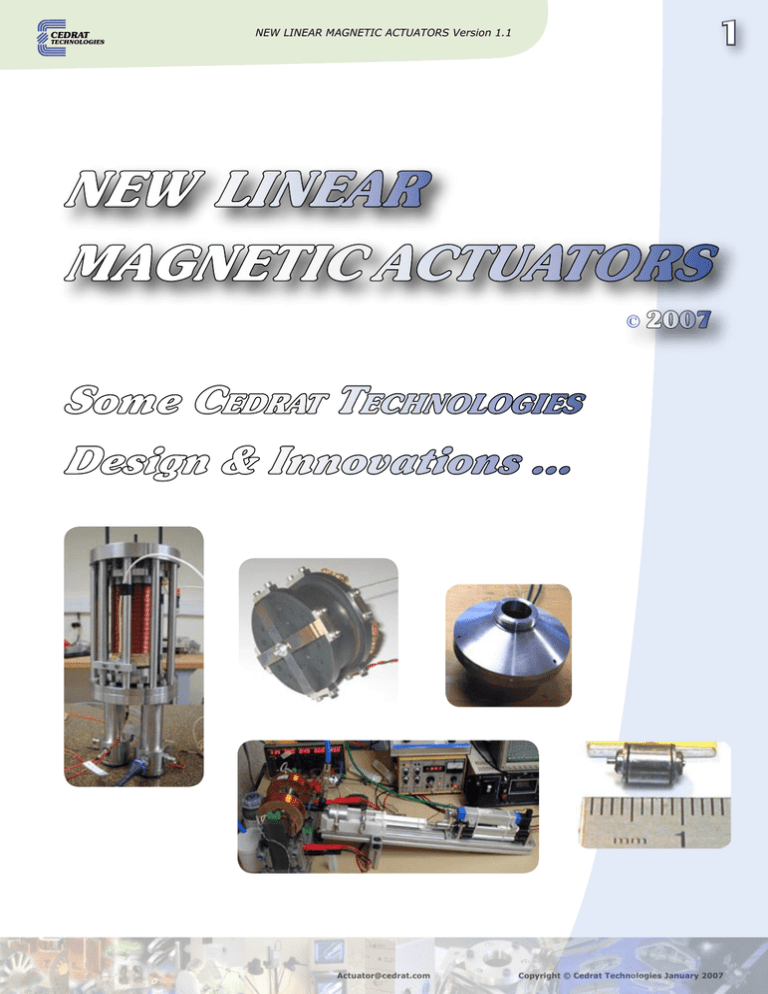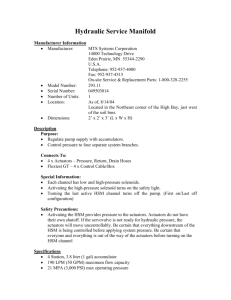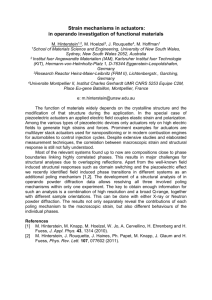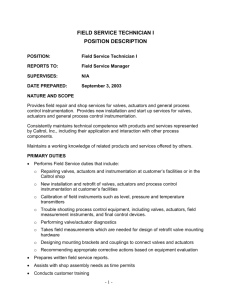
CEDRAT
TECHNOLOGIES
1
NEW LINEAR MAGNETIC ACTUATORS Version 1.1
NEW LINEAR
MAGNETIC ACTUATORS
© 2007
Some CEDRAT TECHNOLOGIES
Design & Innovations ...
Actuator@cedrat.com
Copyright © Cedrat Technologies January 2007
2
Copyright © Cedrat Technologies January 2007
NEW LINEAR MAGNETIC ACTUATORS Version 1.1
Actuator@cedrat.com
CEDRAT
TECHNOLOGIES
3
NEW LINEAR MAGNETIC ACTUATORS Version 1.1
CEDRAT
TECHNOLOGIES
Table of contents
Introduction
5
CEDRAT TECHNOLOGIES facilities
7
Moving Coil Actuators
8
Moving Magnet Actuators
10
Moving Iron Actuators
12
Magnetostrictive Actuators
14
MRF Actuators
16
Legal Notice
18
Actuator@cedrat.com
Copyright © Cedrat Technologies January 2007
4
Copyright © Cedrat Technologies January 2007
NEW LINEAR MAGNETIC ACTUATORS Version 1.1
Actuator@cedrat.com
CEDRAT
TECHNOLOGIES
CEDRAT
TECHNOLOGIES
5
NEW LINEAR MAGNETIC ACTUATORS Version 1.1
INTRODUCTION
CEDRAT TECHNOLOGIES
CEDRAT TECHNOLOGIES SA is a high tech SME of CEDRAT Group involving 70
peoples located in ‘Inovallée’, the French Valley of Innovation, close to Grenoble.
CEDRAT TECHNOLOGIES develops and manufactures high performance ElectroMechanical Components & Systems, especially Actuators & Electronics, which can meet
needs from SME to prestigious customers as CNES, EADS, ESA, LG, NASA… :
● Piezo Actuators: Piezoelectric actuators can be developed as customized products.
They are also available as off-the-shelf products : see separate documentation ‘Piezo
Actuators & Electronics’ from CEDRAT TECHNOLOGIES or www.cedrat.com .
● New Magnetic Actuators: Magnetic actuators are developed by CEDRAT
TECHNOLOGIES as customized products : Several examples of such developments are
presented in this document.
What CEDRAT TECHNOLOGIES proposes
through this document ?
This document presents several realisations of New Magnetic Actuators from CEDRAT
TECHNOLOGIES and provides their technical performances. The presented technical
characteristics reveal what the considered technology is able to achieve.
These actuators are not available as standard products, but as ‘technological bricks’.
So, if interested in such a technology, CEDRAT TECHNOLOGIES can develop similar
products upon customer specification.
Developments of new Magnetic Actuators
Upon request, CEDRAT TECHNOLOGIES performs step-by-step developments in
partnership with its customers:
● Analysis of customer specifications:
A preliminary analysis by CEDRAT
TECHNOLOGIES is free of charge. From this analysis, CEDRAT TECHNOLOGIES emits a
formal proposal, including commitments, work programs, prices and delivery time.
● Design: A pre dimensioning or a feasibility analysis in case of very specific need,
is realized using available design tools, before to perform the detail design. CEDRAT
TECHNOLOGIES can apply Design Standards (for example ESA ECSS). At each stage,
the customer gets the results, which generally a Detailed Design Report. CEDRAT
TECHNOLOGIES accepts to perform such a Design work even if not in charge of the
Prototyping, Testing and Manufacturing.
Actuator@cedrat.com
Copyright © Cedrat Technologies January 2007
6
NEW LINEAR MAGNETIC ACTUATORS Version 1.1
CEDRAT
TECHNOLOGIES
● Prototyping & testing: The prototyping & testing is performed according to
specifications or following the defined work program. The test program can include a
complete qualification. CEDRAT TECHNOLOGIES has already delivered several FLIGHT
MODELS for space or aircraft applications. CEDRAT TECHNOLOGIES can apply Design
Standards (for example ESA ECSS), a Quality Product Assurance Plan and a Configuration
Management Plan. CEDRAT TECHNOLOGIES accepts to perform such a Prototyping &
Testing works even if not in charge of the Manufacturing.
● Industrialisation & Manufacturing: CEDRAT TECHNOLOGIES can manufacture small
or medium series of customized products. This can be performed applying a Quality
Product Assurance Plan. In 2005, the number of manufactured actuators has reached
1000 units.
Copyright © Cedrat Technologies January 2007
Actuator@cedrat.com
CEDRAT
TECHNOLOGIES
7
NEW LINEAR MAGNETIC ACTUATORS Version 1.1
Cedrat Technologies Facilities
The R&D facilities used by CEDRAT to develop these technologies include advanced
modeling CAD programs.
● FLUX 2D/3D is a standard Finite Element Method (FEM) software for the design of
magnetic devices.
● ATILA 3D is a FEM software dedicated to the modeling of 2D/3D structures including
active materials such as magnetostrictives and piezoelectrics.
● ADINA is a FEM software used for Computation of Flow Dynamics (CFD).
● I-DEAS is a CAD software used for the mechanical & thermal computation &
design.
● MATLAB-SIMULINK, SPICE, DXP are software for the computation & design of
driving & control electronics.
The R&D facilities include also workshop facilities and Test Equipment adapted to
Electric Engineering and Electro-mechanics:
●
●
●
●
●
●
●
●
●
●
2D/3D metrology
Clean assembly room
Thermal-Vacuum chambers
Vibration shakers
PCs with LABVIEW
Laboratory power supplies and amplifiers, including lock-in amplifier
Impedance analyzer
Spectrum analyzer
Gaussmeters, permeameter
Laser interferometers / vibrometers
Thermal-Vacuum Test Chamber.
Force Measurement of the VC-1
moving coil.
Electromechanical labs : Class 100 Clean assembly, Supplys & Vibrometers bench.
Actuator@cedrat.com
Copyright © Cedrat Technologies January 2007
8
NEW LINEAR MAGNETIC ACTUATORS Version 1.1
CEDRAT
TECHNOLOGIES
Moving Coil Actuators
Principle
The Moving Coil Actuators are based on the Laplace (or Lorentz) force, which
is strictly proportional to the applied current. A coil is placed into a magnetic field
perpendicular to the coil winding. Applying a current into the coil produces a magnetic
force to coil winding along the third direction. They have no blocking force at rest.
Moving Coil Actuators are also called Voice Coil or Lorentz actuators.
Design issues
Although Moving Coil Actuators are rather simple structures, their design can be
customized thanks to following parameters:
● Magnetic Force: It is determined by the product of the coil current and the
magnetic field. The magnetic circuit including a permanent magnet produces such a
field. If the power dissipation need to be reduced, the magnetic field should be enlarged,
which can be done to the price a larger magnetic circuit. If the actuator mass should be
optimized, the current should be increased, which can be done to the price of a larger
heating. A trade-off is generally performed between these two ways. Note that force is
proportional to the applied current, but it depends on the position.
● Thermics: The thermics of a moving coil results not only of the previous trade-off
but also of design of the heat exchange. As the coil is not in contact with iron, the heat
exchange is difficult especially in vacuum application. In this case thermal drains should
be considered.
● Guiding: The guiding can take benefit of the absence of transverse forces in a
moving coil to use an elastic guiding. This is interesting to get a wear-free & hysteresisfree actuator.
● Environment: CEDRAT TECHNOLOGIES has developed voice coil actuators for
specific environments such as Vacuum for space and instruments applications.
Structure of the VC-1 Moving Coil.
FLUX Magnetic Design.
Copyright © Cedrat Technologies January 2007
Actuator@cedrat.com
9
NEW LINEAR MAGNETIC ACTUATORS Version 1.1
CEDRAT
TECHNOLOGIES
Performances
Typical performances are given in the following table. This table is not exhaustive as
many other actuators can be rapidly designed by Cedrat Technologies using its design
tools, lab facilities and technological know-how.
References
Notes
Stroke
Maximal force in air
Peak force in air
Maximal force in vacuum
Maximal current in air
Maximal current in vacuum
Peak current
Dissipated power in air
Dissipated power in vacuum
Dissipated peak power
Mass
Moving mass
Stiffness
Eigen frequency
Dimensions
Mechanical interface
Electrical interface
Unit
mm
N
N
N
A
A
A
W
W
W
g
g
N/mm
Hz
mm
VC-1
Space product
3
30
90
13
16
7
50
28
5,5
280
500
50
1.8
30
71 * 71 * 49
Housing : 4 * M3
2 wires AWG
VC-2
Preliminary
3
42
127
18
16
7
50
28
5,5
280
500
50
1.8
30
71 * 71 * 47
Housing : 4 * M3
2 wires AWG
Applications
Moving Coil Actuators find applications as loudspeakers, vibration generators, micro/
nano positioning, proof-mass dampers for active control of vibrations. They are used in
Instrumentation and space, but are also considered in automotive industry.
For short stokes, Moving Coil Actuators are in competition with Amplified Piezoelectric
Actuators from CEDRAT TECHNOLOGIES. For long stroke, they are in competition with
Moving Iron Controllable Actuators, a new technologies from CEDRAT TECHNOLOGIES.
VC-1 Voice Coil
Actuator.
Thermal-Vacuum Test of the VC-1
Force vs stroke @constant current.
Actuator@cedrat.com
Copyright © Cedrat Technologies January 2007
10
NEW LINEAR MAGNETIC ACTUATORS Version 1.1
CEDRAT
TECHNOLOGIES
Moving Magnet Actuators
Principle
The Moving Magnet Actuators are based on a permanent magnet moving between
to opposite electromagnets. They provide two stable positions at rest. Supplying one
electromagnet to provide a magnetic field pulse adding to the permanent magnet field
and making the opposite with the second electro magnet allows the permanent magnet
to move toward the first electromagnet, and vice-versa.
For this reason, they are also called bi-stable actuators or flip-flop actuators.
Design issues
Moving Magnet Actuators are rather complex structures needing a careful design,
which can benefit of FLUX FEM software from CEDRAT S.A.:
● Magnetic Forces: The static force at rest is determined by the permanent magnet
size. The actuation force depends of the stroke and varies a lot along the strokes. The
actuation force is minimum when the moving magnet is leaving its initial position. Design
should take care of this issue in combination with the load. In addition, transversal forces
are not negligible as soon as there are some play in the guiding, which may damage
bearings.
● Thermics: There is no power at rest, so no heating at rest. Heating is meet only
in operation when the switching frequency is going up.
● Miniaturization: For specific applications, CEDRAT TECHNOLOGIES has investigated
the possibility of miniaturizing Moving Magnet Actuators leading to Micro Bistable Linear
Moving Magnets BLMM.
BLMM-1Micro
bistable Actuator.
Principle of a moving magnet actuator.
BLMM1-1 Micro Actuator response
[Current : 1A = 100mV]; [position : 80µm
= 1V]; [Speed : 125mm/s = 1V];
Copyright © Cedrat Technologies January 2007
Actuator@cedrat.com
11
NEW LINEAR MAGNETIC ACTUATORS Version 1.1
CEDRAT
TECHNOLOGIES
Performances
Typical performances are given in the following table. This table is not exhaustive as
many other actuators can be rapidly designed by Cedrat Technologies using its design
tools, lab facilities and technological know-how.
References
Notes
Stroke
Holding force at rest (Fh)
Actuation force at start stroke (Fs) for I npc
Actuation force at end stroke (Fe) for I npc
Electrical interface
Nominal pulse voltage
Nominal pulse current I npc
Pulse width
Switch response time
Maximal speed
Impact speed
Winding resistance
Temperature rise for 10 switch/s
Moving mass
Total mass
Diameter
Height
Usefull force Fs/ mass / curent
Usefull force Fe/ mass / curent
Unit
BLMM-1
mm
N
N
0,62
0,093
0,033
preliminary
3
50
10
N
0,6
2 wires
+/- 2,6
+/- 5,4
0,63
2,7
437
265
0,48
3,5
76
0,8
5
6,7
7,64
138,19
> 100
2 wires
TBD
TBD
TBD
10
TBD
TBD
TBD
TBD
15
50
25
20
TBD
TBD
V
A
ms
ms
mm.s-1
mm.s-1
ohm
°C
mg
g
mm
mm
mN/g/A
mN/g/A
BLMM-2
Applications
Moving Magnet Actuators find applications as bi-stable actuators, locking actuators,
electro-valves vibration generators, …
They are used in electric industry, production industry, air&space industry, and are
considered for Braille application, ink jet printers...
Collaborations, Supports
CEDRAT TECHNOLOGIES is supported by Oseo French Innovation Agency.
Actuator@cedrat.com
Copyright © Cedrat Technologies January 2007
12
NEW LINEAR MAGNETIC ACTUATORS Version 1.1
CEDRAT
TECHNOLOGIES
Moving Iron Actuators
Principle
The Moving Iron Actuators are more generally called electromagnets. They use the
magnetic attraction force that exists between two soft magnetic parts in presence of a
magnetic field. This force is due to a minimization of the system magnetic reluctance. It
is generally much higher than Laplace force used in Moving Coil Actuators.
In principle, the magnetic force is intrinsically quadratic meaning that only attraction
forces can be produced. To get it back, a return spring is added, leading to one fixed
position at rest. Such an actuator is generally not able to perform control functions (like
accelerating/breaking for fast positioning, all along the stroke).
However New Moving Iron Controllable Actuators, called MICA, allow to circumvent
this limitation and to get high forces controllable actuators.
Design issues
Moving Iron Actuators are rather complex structures needing a careful design, which
can benefit of FLUX FEM software from CEDRAT S.A. This software allows combining
magnetic analysis and mechanical effects such as return springs:
● Magnetic Forces: In usual cases, the static force at rest is determined by the
spring force. The magnetic force varies with the position. In the rest position, the
magnetic force is the smallest as this force increase when the air gap decreases. To get
a more constant force along the stroke, a usual way consists in conic air gap.
● High Forces Controllable Actuators (MICA): For applications requiring high forces
long stroke controllable actuators, CEDRAT TECHNOLOGIES has investigated new
concept of Moving Iron Controllable Actuators (MICA). Such new actuators can provide
both positive and negative forces all along the stroke, depending on the applied current
sign. For this reason, MICA can compete with Moving Coil Actuators and can address
mechatronic applications.
● MICA compared to Moving Coil Actuators: Compared to Moving Coil Actuators,
MICA offers much higher forces, are less sensitive to heating and are more robust. Wires
are fixed. The moving part is stiff and can drive heavy
loads.
FEM FLUX magnetic
design of standard Moving
Iron Actuator.
Copyright © Cedrat Technologies January 2007
Standard Moving Iron Actuator
with a conic air gap and a return
spring.
Actuator@cedrat.com
Force vs stroke for the MICA50-4 for
positive to negative currents.
CEDRAT
TECHNOLOGIES
13
NEW LINEAR MAGNETIC ACTUATORS Version 1.1
Performances
Typical performances are given in the following table. This table is not exhaustive as
many other actuators can be rapidly designed by Cedrat Technologies using its design
tools, lab facilities and technological know-how.
References
Notes
Stroke
Maximal force in air
Peak current density
Dissipated peak power
Side
Height
Mass
Moving mass
Force / mass
1/2
Force / power
Electrical interface
Unit
mm
N
A/mm²
W
mm
mm
g
g
N/kg
1/2
N/W
MICA40-3
Preliminary
3
+/- 40
8
8
39*39
80
360
100
111
14
2 wires AWG
MICA170-4
Preliminary
4
+/- 172
10
52
60
55
716
300
240
24
2 wires AWG
CAD Assembly of the MICA40.
Applications
Moving Iron Actuators find applications as circuit breakers, on-off electro valves,
locking actuators, …
They are used in electric industry, air & space industry, car industry, ...
New controllable actuators are considered for high vibration generation, high power
loud-speaker, active damping applications, smart circuit breakers…
Collaborations, Supports
CEDRAT TECHNOLOGIES is supported by Oseo French Innovation Agency.
CEDRAT TECHNOLOGIES is the laboratory managing SCHNEIDER ELECTRIC Thesis
‘Controllable Linear Magnetic Actuators for circuit breakers’.
High power loud-speaker based on MICA concept (right) compared to the initial movingcoil loud-speaker (left). In this application, MICA offer 3 times more forces, twice more
displacement, while requesting twice less power and being much smaller
Courtesy of MADE.
Actuator@cedrat.com
Design of a High Power loud-speaker
based on a MICA Moving Iron
Controllable Actuator.
Copyright © Cedrat Technologies January 2007
14
NEW LINEAR MAGNETIC ACTUATORS Version 1.1
CEDRAT
TECHNOLOGIES
Magnetostrictive Actuators
Principle
The Magnetostrictive Actuators are solid state magnetic actuators. A currentdriven coil surrounding the magnetostrictive rod generates the expansion of the rod.
Magnetostrictive Actuators need a magnetic bias to present a linearised response, which
can performed either by a DC current in the coil or permanent magnets.
Magnetic field induced strain materials are classically represented by Giant
Magnetostrictive Materials (GMM) such as Rare earth-iron discovered by A.E.Clark.
These materials feature magnetostrains which are two orders of magnitude larger than
Nickel. Among them, bulk Tb0.3Dy0.7Fe1.9, called Terfenol-D, is commercially available
since 1987 and presents the best compromise between a large magnetostrain and a
low magnetic field, at room temperature. Positive magnetostrains of 1000 to 2000 ppm
(0.1-0.2%) obtained with fields of 50 to 200 kA/m are reported for bulk materials,
opening the possibility of building high power transducers and low voltage high force
density actuators. More recently, the family of smart magnetic materials has been
extended with Magnetic Shape Memory Materials (MSM) such as NiMnGa alloys offering
a magnetostrain of up to 6%. These materials basically behave as Giant Magnetostrictive
Materials.
Design issues
Magnetostrictive Actuators are complex structures needing a careful design, which
can benefit of ATILA FEM for magnetostrictive and piezoelectric devices, from CEDRAT
S.A. and of FLUX FEM software for magnetics. ATILA software allows 3D computation of
the structure strain vs applied electric current accounting for magnetoelastic coupling:
● Forces: Magnetostrictive actuators can offer large forces because of high coupled
stresses (up to 50Mpa) and availability of rods with large section (more than 50mm in
diameter).
● Stroke: Stroke is governed by the expansion of the active rod and by its length
(up to 200mm). Stroke can be amplified using a mechanical amplified such as a shell.
● Voltage: The excitation voltage can be adjusted using the coil number of turns.
With high current and large section wires, the required magnetic field can be produced
with a low voltage (less than 12V if needed).
Miniature Direct Magnetostrictive Actuator
DMA XSLarge Direct Magnetostrictive
Actuator DMA L.
Copyright © Cedrat Technologies January 2007
Amplified Magnetostrictive Actuator AMA
Modeling of the AMA magnetostrain with ATILA
FEM.
Actuator@cedrat.com
15
NEW LINEAR MAGNETIC ACTUATORS Version 1.1
CEDRAT
TECHNOLOGIES
Performances
Typical performances are given in the following table. This table is not exhaustive
as many other actuators can be rapidly designed by Cedrat Technologies using its design
tools, lab facilities and technological know-how.
References
Notes
Stroke
Maximal force
Maximal frequency
Voltage
Dissipated DC power
Diameter
Height
Mass
Electrical interface
Unit
DMA XS
DMA L
DMA XL
µm
N
kHz
V
W
mm
mm
g
2
250
5
12
10
8
5
10
2 wires AWG
110
1570
2
12
10
115
180
9300
2 wires AWG
100
21000
1
12
20
130
180
12000
2 wires AWG
Applications
Magnetostrictive Actuators are in strong competition with the standard piezo electric
actuators such as PPAs and APAs (see catalogue http://www.cedrat.com/hardware/
piezo_actuators/piezo_actuators.htm) from CEDRAT TECHNOLOGIES.
They find applications as sound generators (sonars), proportional valves, high forces
generators or low voltage actuators (it can be less than 12V) …
They are used in machine tools, gas & petroleum industry, and are considered for
medical, military and space industries...
Collaborations, Supports
CEDRAT TECHNOLOGIES is partner of the FP6 EC MESEMA project with ALENIA,
EADS, TACT, U.Naples, ZIP-LPA, ZFL.
High power (3kW) magnetostrictive sonar
transducer TRIPODE.
Magnetostrictive transducerfor
ultrasonic cleaning.
Actuator@cedrat.com
Magnetostrictive actuator for making
an aircraft hydraulic pump in an
Electro Hydraulic Actuator (EHA).
Copyright © Cedrat Technologies January 2007
16
NEW LINEAR MAGNETIC ACTUATORS Version 1.1
CEDRAT
TECHNOLOGIES
MRF Actuators
Principle
The MRF Actuators are new electromechanical components using Magneto
Rheological Fluids (MRF). These smart fluids are characterized by their capability to
change their rheological properties, especially their viscosity, versus applied magnetic
field. With high enough field, they can switch from a liquid to almost solid body. This
effect is reversible. It operates in few milliseconds.
This effect can be used for generating controllable damping or braking capabilities,
which can be used for making special electro-fluidic actuators.
Design issues
Magneto Rheological Fluid (MRF) Actuators are complex structures needing a careful
design, which can benefit of FLUX FEM software for magnetics and CFD FEM for computing
flow dynamics. Selecting the MRF and performing an appropriate devices design implies
also a good characterization of the MRF magnetic and rheological properties. There are
several ways of using MRF:
● Flow mode : In flow mode, the MRF fluid is flowing in a restriction. Applying a
magnetic field in the restriction reduces the flow because of increased viscous forces.
With high enough field, there is no more flow. This is used for making controllable flow
valves without moving parts.
● Shear mode : In shear mode, the MRF fluid is static and placed between two
surfaces with a relative motion. Applying a magnetic field in the MRF fluid increases the
tangential forces between the two surfaces because of increased viscous force. This is
typically used in clutches.
● Damping effects : Thanks to these properties, MRF may be used to provide
controllable damping forces that require only a relatively small amount of magnetic
energy. Typically the damping coefficient can be increased by 3 to 5 when the field is
applied. This is called semi active damping. These possibilities are used in semi-active
dampers and controllable shock absorbers.
Magnetization
curves B(H) of
various MRF fluids.
Pressure vs Flow @ different B-field of a MRF.
Copyright © Cedrat Technologies January 2007
CEDRAT TECHNOLOGIES test bench of MRF in a
flow mode (active valve mode).
Actuator@cedrat.com
17
NEW LINEAR MAGNETIC ACTUATORS Version 1.1
Performances
Typical performances are given in the following table. This table is not
exhaustive as many other actuators can be rapidly designed by CEDRAT
TECHNOLOGIES using its design tools, lab facilities and technological know-how.
The following MRF actuator (see here below) can be
References
Unit
operated either as a self locking linear brake or as a Notes
mm
semi active damper. Without power supply it offers a Stroke
blocking force @ 0 A
N
strong braking force Fmax holding at rest the out shaft Max
Max blocking force @ 1.6 A
N
all along the stroke. Increasing the DC current applied Total weight
g
mm
to the actuator reduces the force up to less than 5% of Diameter
(without stoke)
mm
Fmax rendering the output shaft free to move. As the Height
Max current
A
braking force can be electrically controlled, this MRF Electrical interface
ohm
actuator can also be used as a semi active damper or Winding resistance
Winding inductance
mH
a semi active shock absorber, requiring low power for Time response
ms
managing large damping forces.
Dissipated power in blocking state (@0A)
W
Dissipated power in free state (@1.6A)
W
A-MRF
30
100
5
580
43
94
1,6
1 coils = 2 wires
1,5
4,3
3 (tbc)
0
4
Applications
MRF Actuators find applications as semi active dampers, smart shock absorbers,
clutches, and brakes…
They are used in automotive industry, civil engineering and are considered in a variety
of applications in aircraft, space craft, machine tools, and even consumer goods.
Collaborations, Supports
CEDRAT TECHNOLOGIES has been partner of the FP6 EC ADLAND (Adaptive
Landing Gear) project with EADS, FhG-ISC, MESSIER DOWTY, IFTR, Institute of Aviation,
USFD, PZL Mielec. CEDRAT TECHNOLOGIES is presently partner of the Eureka project
HYDROSMART (Hydrostatic Bearings For Precision Machinery Lubricated With Ferrofluids
And Active Valves) with DANOBAT, IDEKO, KRAFFT, MGEP, CNRS-LPMC.
ADLAND semi-active
shock absorber under
drop test(Courtesy of
IFTR, IA & ADLAND
project).
Test results without and with control(Courtesy of
IFTR, IA & ADLAND project).
Actuator@cedrat.com
MRF actuator.
Copyright © Cedrat Technologies January 2007
18
NEW LINEAR MAGNETIC ACTUATORS Version 1.1
CEDRAT
TECHNOLOGIES
Legal Notice
Even though CEDRAT TECHNOLOGIES SA makes every effort to ensure the accuracy
of all the information made available to its documentation, the information may be
incomplete or, technically inaccurate or may contain typographical errors. Accordingly,
the information provided may be corrected or changed by CEDRAT TECHNOLOGIES SA
at any time and without notice.
CEDRAT TECHNOLOGIES SA may, at any time and without notice, make changes
or improvements to the products and services offered.
CEDRAT TECHNOLOGIES SA disclaims all liability for any information, inaccuracy
or omission relating to information on its documentation. CEDRAT TECHNOLOGIES shall
bear no liability for any decision taken on the basis of the said information.
The reproduction and use of the information (texts, pictures, diagrams, …)
published by CEDRAT TECHNOLOGIES SA on this documentation is authorised solely for
the purposes of information, for personal and private use. Any reproduction and use of
this information for other purposes is strictly prohibited.
All rights reserved © Copyright January 2007
CEDRAT TECHNOLOGIES SA - Meylan, France.
www.cedrat.com
Copyright © Cedrat Technologies January 2007
Actuator@cedrat.com







